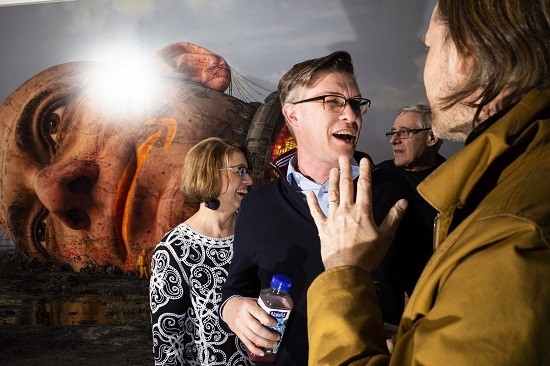A
cavalry of crypto enthusiasts funneled into
Manhattan’s Tribeca neighborhood
Thursday evening, waiting outside Jack Hanley Gallery for a chance to meet
their online art messiah in the flesh. In the mix were celebrities such as
Jimmy Fallon. It was a rock-star welcome for Mike Winkelmann, a digital artist
known as Beeple, who was putting the final touches on his images of decapitated
tech executives and haywire science experiments.
اضافة اعلان
Last year,
Winkelmann, 40, introduced the world to
NFTs (or nonfungible tokens), starting
with the $69 million sale of his “Everydays — The First 5000 Days” at a Christie’s
auction, which set cryptocurrency on a crash course with culture. Now, he is
seeking approval from the art establishment with his first gallery exhibition,
called “Uncertain Future,” which intends to convince critics that his work has
more substance than what they see on screen.
“I’m kind of in a
weird position,” Winkelmann said at the gallery that night. “I’m an outsider in
the traditional art world. I didn’t really feel like that until recently
because I have been making this work in the digital art community for a very
long time.”
 Beeple, the artist known for blockbuster NFT sales, mingles with guests at a show of his physical artwork in New York, March 3, 2022. (Photo: NYTimes)
Beeple, the artist known for blockbuster NFT sales, mingles with guests at a show of his physical artwork in New York, March 3, 2022. (Photo: NYTimes)
So, Winkelmann has
produced an exhibition on walls instead of screens, with 13 paintings and
prints that imagine an apocalyptic future where companies such as
Amazon and
Facebook are reduced to rubble, their founders’ vessels of vanity and greed.
Prices range from $75,000 to $300,000. Not that any of the hundreds who
attended had a chance of buying a Beeple on Thursday night; the artworks were
all on reserve, purchased, by the time the doors opened.
I’m an outsider in the traditional art world. I didn’t really feel like that until recently because I have been making this work in the digital art community for a very long time.
Still, Winkelmann
remains bullish on NFTs, pairing each physical work with a
blockchain-based
collectible for authentication purposes. He said that much of his fortune made
off the metaverse has gone back into his art.
Winkelmann
recently moved into a new nearly 4,645sq.m. industrial studio space in
Charleston, South Carolina. His younger brother, Scott Winkelmann, quit his job
at airplane company Boeing to oversee the 16 full-time employees responsible
for turning the artist’s dreams into realities. (The staff includes several
aerospace engineers from
Boeing.) Other family members have joined the team,
including the sons’ mother, who has an office in the studio complex.
Several advisers
from the worlds of crypto and culture have also joined team Beeple, including
Jehan Chu, a blockchain venture capitalist and NFT collector who attended the
opening.
“Right now, there
are two art worlds,” said Chu, adding that he hoped more museums and galleries
would soften to digital art. “The traditional art world is still learning about
the fundamental values of the NFT space.”
Development for
the exhibition started nine months ago with Winkelmann calling gallerist Jack
Hanley. “I was initially suspicious of all the hype,” the dealer said. “But
Mike has a really cleareyed critique of Big Tech. He’s also very funny.”
Hanley has spent
the last 35 years championing outsider artists such as Raymond Pettibon and
Peter Saul, who slowly gained institutional acceptance after being dismissed
for lacking a formal arts education. Winkelmann could be the next generation,
the dealer said, although not everyone at the gallery agrees; Hanley confirmed
that some artists he represents quit in protest of the Beeple exhibition, as
Artnet News had reported.
The essence of Beeple is kind of between
a satirist and a troll,
Fans say that
Winkelmann’s ability to shock the establishment is part of his appeal.
“The essence of
Beeple is kind of between a satirist and a troll,” said Simon Glenn, 26, a web
developer who was admiring a print that imagines a future Netflix reduced to
broken television sets and rusting cargo containers. “It’s asking what the
company would be like without its people.”
Toward the back of
the gallery, artist Julia Sinelnikova, 32, was admiring a large painting that
features the disfigured head of Jeff Bezos quarantined within an “excess
testosterone dump.” She appreciated that Winkelmann was willing to critique the
leaders of an industry that has supported his work.
“I had been
looking at Beeple’s work for a long time just as entertainment,” Sinelnikova
said, squinting at the artist’s phallus-filled portrait of the Amazon founder.
“But the works here in the gallery are much more beautiful and detailed than I
expected.”
Read more Culture and Arts



